
| ||||
|---|---|---|---|---|
 |
 |
 |
 |
 |



























| ||||
|---|---|---|---|---|
 |
 |
 |
 |
 |


























Piper J3C-65 Cub Special
Single-engine two-seat high-wing propeller-driven light cabin monoplane
Archive Photos 1,2
1940 Piper J3C-65 Cub Special (NC32503, s/n 5398) on display at the 2000 Santa Paula Airshow, Santa Paula, California (Photos by John Shupek)

1941 Piper J3C-65 Cub Special (N35773, s/n 6578) on display at the National Air and Space Museum Steven F. Udvar-Hazy Center, Chantilly, Virginia, 02-16-2004 (Jim Hough photo)

1946 Piper J3C-65 Cub Special (N92041, s/n 16474) on display at the at the Camarillo Air Show, Camarillo, California (Photos by John Shupek)





1946 Piper J3C-65 Cub Special Li’Panda (N92497, s/n 16921) on display at the 2006 Cable Air Show (1/7/2006), Cable Airport, Upland, California (Photos by John Shupek)





1946 Piper J3C-65 Cub Special Li’Panda (N92497, s/n 16921) on display at the 2009 Cable Air Show (1/11/2009), Cable Airport, Upland, California (Photos by John Shupek)
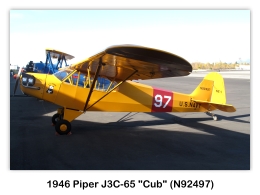
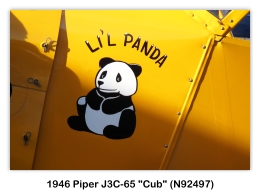
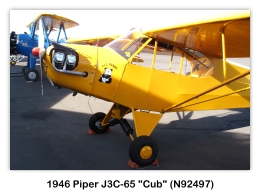
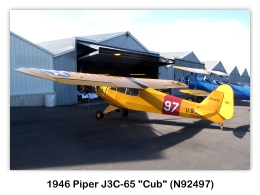
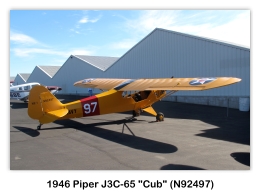
1946 Piper J3C-65 Cub (NC16585, s/n 17868) on display at the MCAS El Toro, California (Photos by John Shupek)
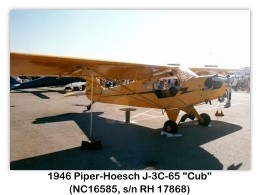
1946 Piper J3C-65 Cub Special (N6944H, s/n 20183) c.2003 on display at the Planes of Fame Air Museum, Chino, California (Photos by John Shupek)



1946 Piper J3C-65 Cub Special (NC3403K, s/n 22094) c.2003 on display EAA AirVenture Museum, Oshkosh, Wisconsin (Photos by John Shupek)


1946 Piper J3C-65 Cub Special Daisy (N3624K, s/n 22317) c.2006 on display at the Camarillo Air Show, Camarillo, California (Photos by John Shupek)



1946 Piper J3C-65 Cub Special (N3231N, s/n 22423) on display at the Hawthorne Air Faire, Hawthorne, California (Photos by John Shupek)

1947 Piper J3C-65 Cub Special (N4491M, s/n 22611) at the Kalamazoo Aviation History Museum, Portage, Michigan (Photos by John Shupek)

Overview 3
The Piper J-3 Cub is a small, simple, light aircraft that was built between 1937 and 1947 by Piper Aircraft. With tandem (fore and aft) seating, it was intended for flight training but became one of the most popular and best-known light aircraft of all time. The Cub’s simplicity, affordability and popularity invokes comparisons to the Ford Model T automobile.
The aircraft’s standard chrome yellow paint has come to be known as Cub Yellow or Lock Haven Yellow.
Pre-war 3
The Taylor E-2 Cub first appeared in 1930, built by Taylor Aircraft in Bradford, Pennsylvania. Sponsored by William T. Piper, a Bradford industrialist who had invested in the company, the E-2 was meant to be an affordable aircraft that would encourage interest in aviation. Later in 1930, the company went bankrupt, with Piper buying the assets but keeping founder C. Gilbert Taylor on as president. In 1936, an earlier Cub was altered by employee Walter Jamouneau to become the J-2 while Taylor was on sick leave. When he saw the redesign, Taylor was so incensed that he fired Jamouneau. Piper, however, had encouraged Jamouneau’s changes, and hired him Back. Piper then bought Taylor’s share in the company, paying him US$250 per month for three years.
Although sales were initially slow, about 1,200 J-2s were produced before a fire in the Piper factory ended its production in 1938. After Piper moved his company from Bradford to Lock Haven, the J-3, which featured further changes by Jamouneau, replaced the J-2. The changes mostly amounted to integrating the vertical fin of the tail into the rear fuselage structure and covering it simultaneously with the fuselage, changing the rearmost side window’s shape to a smoothly curved half-oval outline, and placing a true steerable tailwheel at the rear end of the J-2’s leaf spring-style tailskid, linked for its steering function to the lower end of the rudder with springs and lightweight chains to either end of a double-ended rudder control horn. Powered by a 40 hp (30 kW) engine, in 1938, it sold for just over $1,000.
A number of different air-cooled engines, most of flat-four configuration, were used to power J-3 Cubs, resulting in differing model designations for each type: the J3C models used the Continental A series, the J3F used the Franklin 4AC, and the J3L used the Lycoming O-145. A very few examples, designated J-3P, were equipped with Lenape Papoose 3-cylinder radial engines.
The outbreak of hostilities in Europe in 1939, coupled with the growing realization that the United States might soon be drawn into World War II, resulted in the formation of the Civilian Pilot Training Program (CPTP). The Piper J-3 Cub became the primary trainer aircraft of the CPTP and played an integral role in its success, achieving legendary status. 75 percent of all new pilots in the CPTP (from a total of 435,165 graduates) were trained in Cubs. By war’s end, 80 percent of all United States military pilots had received their initial flight training in Piper Cubs.
The need for new pilots created an insatiable appetite for the Cub. In 1940, the year before the United States’ entry into the war, 3,016 Cubs had been built; wartime demands soon increased that production rate to one Cub being built every 20 minutes.
Flitfire 3
Prior to the United States entering World War II, J-3s were part of a fund-raising programs to support the United Kingdom. Billed as a Flitfire, a Piper Cub J3 bearing Royal Air Force insignia was donated by W. T. Piper and Franklin Motors to the RAF Benevolent Fund to be raffled off. Piper distributors nationwide were encouraged to do the same. On April 29, 1941 all 49 Flitfire aircraft, one for DC and one for each of the 48 US states, flew into La Guardia Field for a dedication and fundraising event which included Royal Navy officers from the battleship HMS Malaya, in New York for repairs, as honored guests. At least three of the original Flitfires are known to exist in the 21st century — one, on display and restored to its original silver-doped finish, powered with a Franklin 65 engine it is on display at the North Carolina Aviation Museum in Asheboro, North Carolina. This Flitfire was flown by Orville Wright in a war bond promotion campaign.
World War II Service 3
The Piper Cub quickly became a familiar sight. First Lady Eleanor Roosevelt took a flight in a J-3 Cub, posing for a series of publicity photos to help promote the CPTP. Newsreels and newspapers of the era often featured images of wartime leaders, such as Generals Dwight Eisenhower, George Patton and George Marshall, flying around European battlefields in Piper Cubs. Civilian-owned Cubs joined the war effort as part of the newly formed Civil Air Patrol (CAP), patrolling the Eastern Seaboard and Gulf Coast in a constant search for German U-boats and survivors of U-boat attacks.
Piper developed a military variant ("All we had to do," Bill Jr. is quoted as saying, "was paint the Cub olive drab to produce a military airplane"), variously designated as the O-59 (1941), L-4 (after April 1942), and NE (U.S. Navy). The L-4 Grasshopper was mechanically identical to the J-3 civilian Cub, but was distinguishable by the use of a Plexiglas greenhouse skylight and rear windows for improved visibility, much like the Taylorcraft L-2 and Aeronca L-3 also in use with the US armed forces. Carrying a single pilot and no passenger, the L-4 had a top speed of 85 mph (137 km/h), a cruise speed of 75 mph (121 km/h), a service ceiling of 12,000 ft (3,658 m), a stall speed of 38 mph (61 km/h), an endurance of three hours, and a range of 225 mi (362 km).[16] 5,413 L-4s were produced for U.S. forces, including 250 built for the U.S. Navy under contract as the NE-1 and NE-2.
All L-4 models, as well as similar, tandem-cockpit accommodation aircraft from Aeronca and Taylorcraft, were collectively nicknamed Grasshoppers, though the L-4 was almost universally referred to by its civilian designation of Cub. The L-4 was used extensively in World War II for reconnaissance, transporting supplies, artillery spotting duties, and medical evacuation of wounded soldiers. During the Allied invasion of France in June 1944, the L-4’s slow cruising speed and low-level manueverability made it an ideal observation platform for spotting hidden German tanks waiting in ambush in the hedgerowed bocage country south of the invasion beaches. For these operations the pilot generally carried both an observer/radio operator and a 25-pound communications radio, a load that often exceeded the plane’s specified weight capacity. After the Allied breakout in France, L-4s were also sometimes equipped with improvised racks of infantry bazookas for ground attack against German armored units. The most famous of these L-4 ground attack planes was Rosie the Rocketeer, piloted by Major Charles "Bazooka Charlie" Carpenter, whose six bazooka rocket launchers were credited with eliminating six enemy tanks and several armored cars during its wartime service.
After the war, many L-4s were sold as surplus, but a considerable number were retained in service. L-4s sold as surplus in the U.S. were redesignated as J-3s, but often retained their wartime glazing and paint.
Postwar 3
An icon of the era, and of American general aviation in general, the J-3 Cub has long been loved by pilots and non-pilots alike, with thousands still in use today. Piper sold 19,073 J-3s between 1938 and 1947, the majority of them L-4s and other military variants. Postwar, thousands of Grasshoppers were civilian-registered under the designation J-3. Hundreds of Cubs were assembled from parts in Canada (by Cub Aircraft as the Cub Prospector), Denmark and Argentina, and by a licensee in Oklahoma.
In the late 1940s, the J-3 was replaced by the Piper PA-11 Cub Special (1,500 produced), the first Piper Cub version to have a fully enclosed cowling for its powerplant, and then the Piper PA-18 Super Cub, which Piper produced until 1981 when it sold the rights to WTA Inc. In all, Piper produced 2,650 Super Cubs. The Super Cub had a 150 hp (110 kW) engine which increased its top speed to 130 mph (210 km/h); its range was 460 miles (740 km).
Korean War Service 3
The L-4 was used extensively by both U.S. and South Korean Air Forces in the early 1950s. During the Korean War, the L-4 saw service in many of the same roles it had performed during World War II, such as artillery spotting, forward air control, and reconnaissance. Some L-4s were fitted with a high-Back canopy in order to carry a single stretcher for medical evacuation of wounded soldiers.
Modern Production 3
Modernized and up-engine versions are produced today by Cub Crafters of Washington and by American Legend Aircraft in Texas, as the Cub continues to be sought after by bush pilots for its STOL capabilities, as well as by recreational pilots for its nostalgia appeal. The new aircraft are actually modeled on the PA-11, though the Legend company does sell an open-cowl version with the cylinder heads exposed, like the J-3 Cub. An electrical system is standard from both manufacturers.
So popular is the J-3 as a subject for radio controlled model aircraft that manufacturers of R/C heat shrinkable iron-on covering film and similar fabric coverings produce it in a readily available Cub Yellow hue.
The J-3 is distinguished from its successors by having a cowl that exposes its engine’s cylinder heads. There are very few other examples of "flat" aircraft engine installations (as opposed to radial engines) in which the cylinder heads are exposed. From the PA-11 on through the present Super Cub models, the cowling surrounds the cylinder heads.
A curiosity of the J-3 is that when it is flown solo, the lone pilot normally occupies the rear seat for proper balance, to balance the fuel tank located at the firewall. Starting with the PA-11, and some L-4s, fuel was carried in wing tanks, allowing the pilot to fly solo from the front seat.
Civil Variants 3
Military Designations and Variants 3
Civil Operators 3
Military Operators 3
Specifications (J3C-65) 4,5
Type
Wings
Fuselage
Tail Unit
Landing Gear
Power Plant
Accommodation
Dimensions
Areas
Weights and Loadings
Performance
References